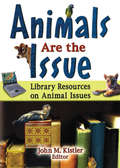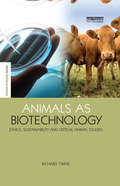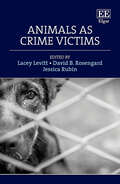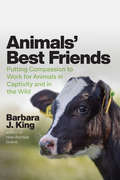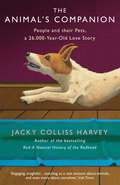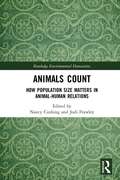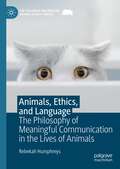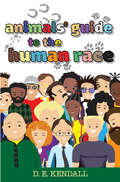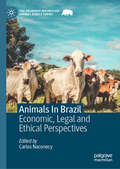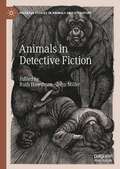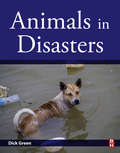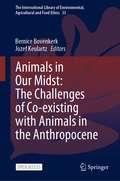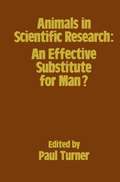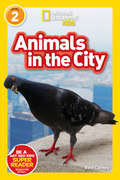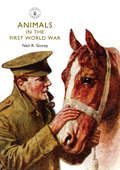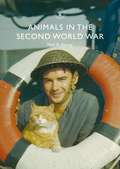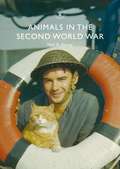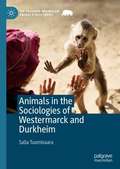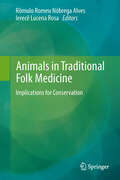- Table View
- List View
Animals are the Issue: Library Resources on Animal Issues
by Linda S KatzSupply your library with the best collection of resources on animal issues! Animals are the Issue: Library Resources on Animal Issues is a guide to books, journals, and Web sites on historic and modern animal treatment. Expert librarians and scholars provide helpful resources showing what ideals and practical solutions exist in animal rights and welfare debates. With this book, students, philosophers, and politicians can find the best of written and electronic resources about the protection and ethical use of animals by humankind. Animals are the Issue stands alone as a source for locating materials on animal protection and welfare. This valuable guide will help librarians save time and money in locating diverse areas of information regarding animal consumption and exploitation. The authors have noted what they consider to be the most essential resources for library collections. This book offers references that discuss the utilization of animals by humans: as companions in sports and entertainment in religion in science and education in industry in hunting Animals Are the Issue explores how animals are seen, viewed, and used by humans. With bibliographies, annotated lists, and short commentaries by the authors on nearly every item, you&’ll be able to supply your patrons with a highly effective animal rights/welfare collection.
Animals are the Issue: Library Resources on Animal Issues
by Linda S KatzSupply your library with the best collection of resources on animal issues! Animals are the Issue: Library Resources on Animal Issues is a guide to books, journals, and Web sites on historic and modern animal treatment. Expert librarians and scholars provide helpful resources showing what ideals and practical solutions exist in animal rights and welfare debates. With this book, students, philosophers, and politicians can find the best of written and electronic resources about the protection and ethical use of animals by humankind. Animals are the Issue stands alone as a source for locating materials on animal protection and welfare. This valuable guide will help librarians save time and money in locating diverse areas of information regarding animal consumption and exploitation. The authors have noted what they consider to be the most essential resources for library collections. This book offers references that discuss the utilization of animals by humans: as companions in sports and entertainment in religion in science and education in industry in hunting Animals Are the Issue explores how animals are seen, viewed, and used by humans. With bibliographies, annotated lists, and short commentaries by the authors on nearly every item, you&’ll be able to supply your patrons with a highly effective animal rights/welfare collection.
Animals as Biotechnology: "Ethics, Sustainability and Critical Animal Studies"
by Richard TwineIn Animals as Biotechnology sociologist Richard Twine places the question of human/animal relations at the heart of sustainability and climate change debates. The book is shaped by the emergence of two contradictory trends within our approach to nonhuman animals: the biotechnological turn in animal sciences, which aims to increase the efficiency and profitability of meat and dairy production; and the emerging field of critical animal studies - mostly in the humanities and social sciences - which works to question the nature of our relations with other animals. The first part of the book focuses on ethics, examining critically the dominant paradigms of bioethics and power relations between human and non-human. The second part considers animal biotechnology and political economy, examining commercialisation and regulation. The final part of the book centres on discussions of sustainability, limits and an examination of the prospects for animal ethics if biotechnology becomes part of the dominant agricultural paradigm. Twine concludes by considering whether growing calls to reduce our consumption of meat/dairy products in the face of climate change threats are in fact complicit with an anthropocentric understanding of sustainability and that what is needed is a more fundamental ethical and political questioning of relations and distinctions between humans, animals and nature.
Animals as Biotechnology: "Ethics, Sustainability and Critical Animal Studies"
by Richard TwineIn Animals as Biotechnology sociologist Richard Twine places the question of human/animal relations at the heart of sustainability and climate change debates. The book is shaped by the emergence of two contradictory trends within our approach to nonhuman animals: the biotechnological turn in animal sciences, which aims to increase the efficiency and profitability of meat and dairy production; and the emerging field of critical animal studies - mostly in the humanities and social sciences - which works to question the nature of our relations with other animals. The first part of the book focuses on ethics, examining critically the dominant paradigms of bioethics and power relations between human and non-human. The second part considers animal biotechnology and political economy, examining commercialisation and regulation. The final part of the book centres on discussions of sustainability, limits and an examination of the prospects for animal ethics if biotechnology becomes part of the dominant agricultural paradigm. Twine concludes by considering whether growing calls to reduce our consumption of meat/dairy products in the face of climate change threats are in fact complicit with an anthropocentric understanding of sustainability and that what is needed is a more fundamental ethical and political questioning of relations and distinctions between humans, animals and nature.
Animals as Crime Victims
This innovative and prescient book offers a multidisciplinary framework which reconceptualizes maltreated animals as crime victims. Articulating more active and involved responses to animal maltreatment, Animals as Crime Victims provides guidance to attorneys, law enforcement personnel, veterinarians, and educators by reimagining how animals are positioned within the law.Lacey Levitt, David B. Rosengard, and Jessica Rubin bring together expert contributors from various fields who argue for reconceptualizing animals as crime victims and examine the legal ramifications of doing so. Chapters explore how recognition as crime victims not only makes animals and their own interests visible within the law but affords them substantive rights. Alongside a proposed legal framework, this incisive book details modern scientific discoveries regarding the complexity of animals' cognition and emotions and the historical and contemporary sociological shifts in our relationships with animals.Animals as Crime Victims will be a vital read for academics, students, and practitioners whose work focuses on animal maltreatment, animal law, or human-animal studies. Including in-depth examples, practical information, and exploration of substantive law alongside legal theory, this book will be useful to lawyers, law enforcement personnel, criminologists, and veterinary and mental health professionals confronting crimes against animals or the humans committing them.
Animals' Best Friends: Putting Compassion to Work for Animals in Captivity and in the Wild
by Barbara J. KingAs people come to understand more about animals’ inner lives—the intricacies of their thoughts and the emotions that are expressed every day by whales and cows, octopus and mice, even bees—we feel a growing compassion, a desire to better their lives. But how do we translate this compassion into helping other creatures, both those that are and are not our pets? Bringing together the latest science with heartfelt storytelling, Animals’ Best Friends reveals the opportunities we have in everyday life to help animals in our homes, in the wild, in zoos, and in science labs, as well as those considered to be food. Barbara J. King, an expert on animal cognition and emotion, guides us on a journey both animal and deeply human. We meet cows living relaxed lives in an animal sanctuary—and cows with plastic portals in their sides at a university research station. We observe bison free-roaming at Yellowstone National Park and chimpanzees confined to zoos. We learn with King how to negotiate vegetarian preferences in omnivore restaurants. We experience the touch of a giant Pacific octopus tasting King’s skin with one of his long, neuron-rich arms. We reflect on animal testing as King shares her own experience as the survivor of a particularly nasty cancer. And in a moment all too familiar to many of us, we recover from a close encounter with two spiders in the home. This is a book not of shaming and limitation, but of uplift and expansion. Throughout this journey, King makes no claims of personal perfection. Though an animal expert, she is just like the rest of us: on a journey still, learning each day how to be better, and do better, for animals. But as Animals’ Best Friends makes clear, challenging choices can bring deep rewards. By turning compassion into action on behalf of animals, we not only improve animals’ lives—we also immeasurably enrich our own.
Animals' Best Friends: Putting Compassion to Work for Animals in Captivity and in the Wild
by Barbara J. KingAs people come to understand more about animals’ inner lives—the intricacies of their thoughts and the emotions that are expressed every day by whales and cows, octopus and mice, even bees—we feel a growing compassion, a desire to better their lives. But how do we translate this compassion into helping other creatures, both those that are and are not our pets? Bringing together the latest science with heartfelt storytelling, Animals’ Best Friends reveals the opportunities we have in everyday life to help animals in our homes, in the wild, in zoos, and in science labs, as well as those considered to be food. Barbara J. King, an expert on animal cognition and emotion, guides us on a journey both animal and deeply human. We meet cows living relaxed lives in an animal sanctuary—and cows with plastic portals in their sides at a university research station. We observe bison free-roaming at Yellowstone National Park and chimpanzees confined to zoos. We learn with King how to negotiate vegetarian preferences in omnivore restaurants. We experience the touch of a giant Pacific octopus tasting King’s skin with one of his long, neuron-rich arms. We reflect on animal testing as King shares her own experience as the survivor of a particularly nasty cancer. And in a moment all too familiar to many of us, we recover from a close encounter with two spiders in the home. This is a book not of shaming and limitation, but of uplift and expansion. Throughout this journey, King makes no claims of personal perfection. Though an animal expert, she is just like the rest of us: on a journey still, learning each day how to be better, and do better, for animals. But as Animals’ Best Friends makes clear, challenging choices can bring deep rewards. By turning compassion into action on behalf of animals, we not only improve animals’ lives—we also immeasurably enrich our own.
The Animal's Companion: People and their Pets, a 26,000-Year Love Story
by Jacky Colliss HarveyThe earliest evidence of a human and a pet can be traced as far back as 26,000 BC in France where a boy and his 'canid' took a walk through a cave. Their foot and paw prints were preserved together on the muddy cave floor, and smoke from the torch the boy carried was left on the walls, allowing archaeologists to carbon-date their journey. And so, the story unfolds, from these prehistoric days all the way up to the present, of our innate and undeniable need to live in the close company of animals. In this startling new work, acclaimed cultural detective and lifelong pet owner Jacky Colliss Harvey uses her compelling storytelling skills and keen eye for historical investigation to examine our role as animals' companions, in this exploration of the history not of the pet, but of us as pet owners. Drawing on literary, artistic and archaeological evidence of our relationships with other species, over thousands of years of human experience, she examines the when, the how and the why of our connection to those animals we take into our lives, assessing these against the latest scientific thinking on this complex and enthralling subject, and suggesting new insights into this most long-standing of all human love-affairs.
Animals Count: How Population Size Matters in Animal-Human Relations (Routledge Environmental Humanities)
by Nancy Cushing Jodi FrawleyWhether their populations are perceived as too large, just right, too small or non-existent, animal numbers matter to the humans with whom they share environments. Animals in the right numbers are accepted and even welcomed, but when they are seen to deviate from the human-declared set point, they become either enemies upon whom to declare war or victims to be protected. In this edited volume, leading and emerging scholars investigate for the first time the ways in which the size of an animal population impacts how they are viewed by humans and, conversely, how human perceptions of populations impact animals. This collection explores the fortunes of amphibians, mammals, insects and fish whose numbers have created concern in settler Australia and examines shifts in these populations between excess, abundance, equilibrium, scarcity and extinction. The book points to the importance of caution in future campaigns to manipulate animal populations, and demonstrates how approaches from the humanities can be deployed to bring fresh perspectives to understandings of how to live alongside other animals.
Animals Count: How Population Size Matters in Animal-Human Relations (Routledge Environmental Humanities)
by Nancy Cushing Jodi FrawleyWhether their populations are perceived as too large, just right, too small or non-existent, animal numbers matter to the humans with whom they share environments. Animals in the right numbers are accepted and even welcomed, but when they are seen to deviate from the human-declared set point, they become either enemies upon whom to declare war or victims to be protected. In this edited volume, leading and emerging scholars investigate for the first time the ways in which the size of an animal population impacts how they are viewed by humans and, conversely, how human perceptions of populations impact animals. This collection explores the fortunes of amphibians, mammals, insects and fish whose numbers have created concern in settler Australia and examines shifts in these populations between excess, abundance, equilibrium, scarcity and extinction. The book points to the importance of caution in future campaigns to manipulate animal populations, and demonstrates how approaches from the humanities can be deployed to bring fresh perspectives to understandings of how to live alongside other animals.
Animals, Ethics, and Language: The Philosophy of Meaningful Communication in the Lives of Animals (The Palgrave Macmillan Animal Ethics Series)
by Rebekah HumphreysWith an ever-growing body of evidence on the links between different oppressions, never have the debates in Critical Animal Studies surrounding intersectionality in relation to animal ethics been more important. In particular, the arguments related to anthropomorphic attributes of mentality to other than humans promise to provide fruitful new ground for re-assessing human-animal relations. This book maps the central debates surrounding anthropomorphism in relation to our descriptions of animals, their lives, animal mentality, and meaningful communication in the nonhuman world. Rebekah Humphreys synthesizes the work of critical animal theorists, philosophers, and cognitive ethologists, and provides a critical account of how the debates concerning anthropomorphism play a key role in a proper understanding of animal ethics.
Animals' Guide to the Human Race
by D. E. KendallLove animals? Life stressing you out? Struggle to find time to read? If you answered "Yes" to any of the above, Animals' Guide is the perfect pick-me-up! Animals' Guide is jam-packed with smile-inducing case studies, provided by animals observing humans. Open any page, read a case study, have a laugh, then get on with your day feeling a little brighter. Witty observations from horses, cats, dogs, and exotic creatures fill the pages with humour. Animals enrich our lives every day; I bet if we could all take our pets to work with us, we'd be so much happier! Escaping reality for even a moment to enjoy some hilarious animal antics really does make a difference...
Animals In Brazil: Economic, Legal and Ethical Perspectives (The Palgrave Macmillan Animal Ethics Series)
by Carlos NaconecyThis book presents a collection of essays exploring the legal, economic, socio-environmental, and ethical dimensions of human-animal interaction in Brazil. As one of the primary global producers and exporters of beef, with a level of biodiversity in its rain-forests found nowhere else under threat, the importance of Brazil for animal life is unquestionable. Shedding light on the profound transformations in the consumption and production of animal-sourced foods that have taken place over the last five decades, the authors examine the consequences of this phenomenon for the lives of animals, the health of the population, and the environment. The book also offers an analysis of the animal welfare and animal protection legislation in Brazil, before presenting a number of notable cases involving animal advocacy and activism in recent years. An important and timely collection, this book concludes with an exploration of the historical, socio-cultural and economic aspects that influence the Brazilian ethos regarding the morality of the treatment of animals.
Animals In The City (Engage Literacy Turquoise Ser.)
by Kelly GaffneyFind out all about the different animals that live in cities.
Animals in Detective Fiction (Palgrave Studies in Animals and Literature)
by Ruth Hawthorn John MillerThis book explores the vast array of animals that populate detective fiction. If the genre begins, as is widely supposed, with Edgar Allan Poe’s “Murders in the Rue Morgue” (1841), then detective fiction’s very first culprit is an animal. Animals, moreover, consistently appear as victims, clues, and companions, while the abstract conception of animality is closely tied to the idea of criminality. Although it is often described as an essentially conservative form, detective fiction can unsettle the binary of human and animal to intersect with developing concerns in animal studies: animal agency, the ethical complexities of human/animal interaction, the politics and literary aesthetics of violence, and animal metaphor. Gathering its 14 essays into sections on ontologies, ethics, politics, and forms, Animals in Detective Fiction provides a compelling and nuanced analysis of the central role creatures play in this enduringly popular and continually morphing literary form.
Animals in Disasters
by Dick GreenAnimals in Disasters is a comprehensive book on animal rescue written by Dr. Dick Green who shares his experiences, best practices and lessons learned from well over 125 domestic and international disasters. It provides a step-by-step process for communities and states to more effectively address animal issues and enhance their animal response capabilities. Sections include an overview of the history of animal rescue, where we are today, and the steps needed to better prepare for tomorrow. This how-to book for emergency managers who want to develop programs, craft policy, and build response capability/capacity is an ideal companion to their work. Clearly identifies the components of building a resilient communityIntroduces the Community Preparedness ChecklistHelps readers develop and deliver effective animal response training
Animals in Our Midst: The Challenges of Co-existing with Animals in the Anthropocene (The International Library of Environmental, Agricultural and Food Ethics #33)
by Bernice Bovenkerk Jozef KeulartzThis Open Access book brings together authoritative voices in animal and environmental ethics, who address the many different facets of changing human-animal relationships in the Anthropocene. As we are living in complex times, the issue of how to establish meaningful relationships with other animals under Anthropocene conditions needs to be approached from a multitude of angles. This book offers the reader insight into the different discussions that exist around the topics of how we should understand animal agency, how we could take animal agency seriously in farms, urban areas and the wild, and what technologies are appropriate and morally desirable to use regarding animals. This book is of interest to both animal studies scholars and environmental ethics scholars, as well as to practitioners working with animals, such as wildlife managers, zookeepers, and conservation biologists.
Animals in Scientific Research (pdf): Proceedings of a Symposium held in April 1982 under the auspices of the Humane Research Trust
by P. TurnerAnimals in the City (National Geographic Readers)
by National Geographic KidsFrom pigeon pizza parties in New York City to koala street crossings in Australia, wild animals all over the world show us how they live in cities, interact with humans, and strut their street smarts in this new reader from National Geographic Kids.
Animals in the First World War (Shire Library #790)
by Neil R. StoreyThe burden of the Great War was not shouldered by soldiers alone: the tasks, the camaraderie, the day-to-day life and the devastation were all shared with the animals that accompanied the forces abroad. The horses that took part in the last cavalry charges or hauled heavy guns are the most famous examples, but were far from alone: pigeons carried vital messages, dogs sniffed out wounded soldiers, camels were used as beasts of burden in the desert, and even ships' cats and baby orang-utans had their parts to play. From noted historian Neil R. Storey, this book looks at all the practical ways in which animals were essential to the war effort, but is equally interested in their roles as companions, mascots and morale boosters – on land, in the air and at sea. Neil R. Storey is a social and military historian specialising in the impact of war on society. He has written over twenty-five books, countless articles and has given lectures across the UK, including at the Imperial War Museum. He has acted as a consultant on a number of television documentaries and dramas.
Animals in the Second World War (Shire Library #880)
by Neil R. StoreyThroughout the course of the Second World War, many millions of animals were enlisted to serve. Though they had no choice, yet they demonstrated loyalty, determination and bravery as they shared the burden of war with their human companions both on active service and on the Home Front. From the dogs trained to locate air-raid victims buried under rubble, to the mules that carried ammunition and supplies through the jungles of the Far East, each animal played a crucial role in the war effort. In fact, such was their contribution that those animals that showed exceptional gallantry or devotion to duty were recognised officially with the introduction of the Dickin Medal in 1943. This fascinating book draws from first-hand accounts and contemporary sources to reveal the wide-ranging contributions that animals made both on and off the battlefield.
Animals in the Second World War (Shire Library)
by Neil R. StoreyThroughout the course of the Second World War, many millions of animals were enlisted to serve. Though they had no choice, yet they demonstrated loyalty, determination and bravery as they shared the burden of war with their human companions both on active service and on the Home Front. From the dogs trained to locate air-raid victims buried under rubble, to the mules that carried ammunition and supplies through the jungles of the Far East, each animal played a crucial role in the war effort. In fact, such was their contribution that those animals that showed exceptional gallantry or devotion to duty were recognised officially with the introduction of the Dickin Medal in 1943. This fascinating book draws from first-hand accounts and contemporary sources to reveal the wide-ranging contributions that animals made both on and off the battlefield.
Animals in the Sociologies of Westermarck and Durkheim (The Palgrave Macmillan Animal Ethics Series)
by Salla TuomivaaraThis book explores why animals, at some point, disappeared from the realm and scope of sociology. The role of sociology in the construction of a science of the ‘human’ has been substantial, building representations of the human sphere of life as unique. Within the sociological tradition however, animals have often been invisible, even non-existent. Through in-depth comparisons of the texts of prominent early sociologists Emile Durkheim and Edward Westermarck, Tuomivaara shows that despite this exclusion, representations of animals and human-animal relations were far more varied in early works than in the later sociological cannon. Addressing a significant gap in the interdisciplinary field of animal studies, Tuomivaara presents a close reading of the historical treatment of animals in the works of Durkheim and Westermarck to determine how the human-animal boundary was established in sociological theory. The diverse forms in which animals and ‘the animal’ appear in the works of early classical sociology are charted and explored, alongside the sociological themes that bring animals into these texts. Situated in contemporary theory, from critical animal studies to posthumanism, this important book lays the groundwork for a disciplinary shift away from this sharp human-animal dualism.
Animals in Traditional Folk Medicine: Implications for Conservation
by Rômulo Romeu Nóbrega Alves and Ierecê Lucena RosaPeople have relied on medicinal products derived from natural sources for millennia, and animals have long been an important part of that repertoire; nearly all cultures, from ancient times to the present, have used animals as a source of medicine. Ingredients derived from wild animals are not only widely used in traditional remedies, but are also increasingly valued as raw materials in the preparation of modern medicines. Regrettably, the unsustainable use of plants and animals in traditional medicine is recognized as a threat to wildlife conservation, as a result of which discussions concerning the links between traditional medicine and biodiversity are becoming increasingly imperative, particularly in view of the fact that folk medicine is the primary source of health care for 80% of the world’s population. This book discusses the role of animals in traditional folk medicine and its meaning for wildlife conservation. We hope to further stimulate further discussions about the use of biodiversity and its implications for wildlife conservation strategies.
